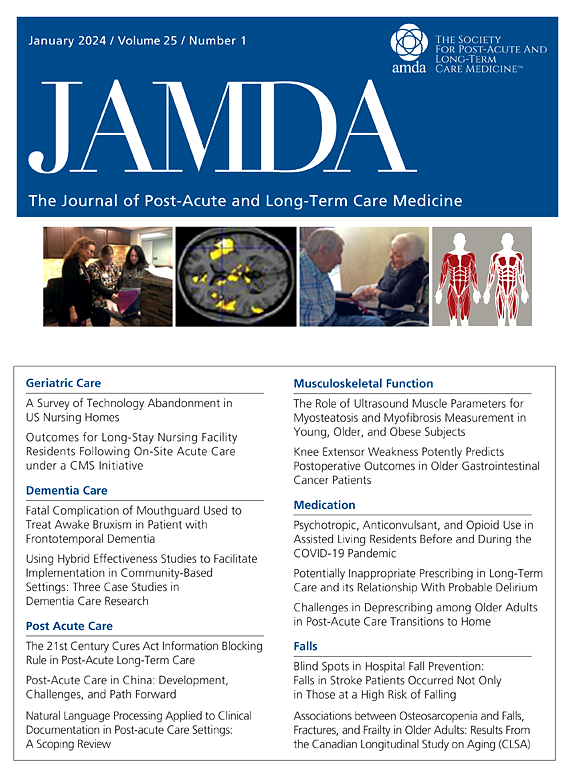The Impact of Nursing Staff Wages on Nursing Home Quality: An Instrumental Variable Approach
IF 3.8
2区 医学
Q2 GERIATRICS & GERONTOLOGY
Journal of the American Medical Directors Association
Pub Date : 2025-06-18
DOI:10.1016/j.jamda.2025.105705
引用次数: 0
Abstract
Objective
Nursing staff are central to ensuing high-quality care in nursing homes (NHs), yet their wages often lag behind those in other health care settings. This study aimed to examine whether higher wages for nursing staff—registered nurses (RNs), licensed practical nurses (LPNs), and certified nursing assistants (CNAs)—were associated with better NH quality.
Design
This was an observational study using panel data from 2020 to 2022.
Setting and Participants
The study included all Centers for Medicare and Medicaid Services–certified US NHs. The analytic data file comprised 37,577 facilities.
Methods
This study used multiple secondary datasets, including the Payroll-Based Journal, Medicare Cost Reports, Care Compare: Five-Star Quality Rating System (Five-Star QRS), and LTCFocus.org. The primary outcome was NH quality, operationalized through the quality domain of the Five-Star QRS. The primary independent variables were the facility-level average hourly wages for RNs, LPNs, and CNAs, adjusted for inflation. To address potential endogeneity, average nursing staff wages at the county level, excluding the index facility, were used as an instrument for wages.
Results
A 1-dollar increase in wages for RNs, LPNs, and CNAs was associated with 12% (95% CI, 1.07–1.17), 10% (95% CI, 1.05–1.15), and 8% (95% CI, 1.07–1.45) higher odds, respectively, of obtaining a higher star rating (P < .001). Marginal effects analysis showed that a 1-dollar increase in wages was associated with a 2.4%, 2.0%, and 1.8% higher likelihood of achieving a 5-star rating for RNs, LPNs, and CNAs, respectively.
Conclusions and Implications
Higher nursing staff wages were associated with increased odds of achieving a higher quality rating. NHs need to offer competitive wages as part of broader efforts to improve quality. Targeted reimbursement strategies may be necessary to support wage increases, especially for facilities serving a high proportion of vulnerable residents.
护理人员工资对养老院质量的影响:一个工具变量法。
目的:护理人员是确保养老院(NHs)高质量护理的核心,但他们的工资往往落后于其他卫生保健机构。本研究旨在探讨护理人员——注册护士(RNs)、执业护士(lpn)和注册护理助理(CNAs)——的高工资是否与更好的护理质量有关。设计:这是一项观察性研究,使用2020年至2022年的面板数据。环境和参与者:该研究包括所有医疗保险和医疗补助服务中心认证的美国国民保健服务。分析数据文件包括37,577个设施。方法:本研究使用了多个辅助数据集,包括基于工资的期刊、医疗保险成本报告、护理比较:五星级质量评级系统(五星QRS)和LTCFocus.org。主要结果是NH质量,通过五星级QRS的质量域进行操作。主要的自变量是按通货膨胀调整后的注册护士、lpn和注册护士的设施水平平均小时工资。为了解决潜在的内生性,在县级护理人员的平均工资,不包括指数设施,被用作一个工具的工资。结果:注册护士、lpn和CNAs的工资每增加1美元,分别与获得更高星级评级的几率增加12% (95% CI, 1.07-1.17)、10% (95% CI, 1.05-1.15)和8% (95% CI, 1.07-1.45)相关(P < 0.001)。边际效应分析显示,工资每增加1美元,注册护士、执业护士和执业护士获得五星评级的可能性分别提高2.4%、2.0%和1.8%。结论和意义:护理人员工资越高,获得高质量评价的几率越大。作为提高医疗质量的更广泛努力的一部分,NHs需要提供有竞争力的工资。有针对性的报销策略可能是必要的,以支持工资增长,特别是对于服务于高比例弱势居民的设施。
本文章由计算机程序翻译,如有差异,请以英文原文为准。
求助全文
约1分钟内获得全文
求助全文
来源期刊
CiteScore
11.10
自引率
6.60%
发文量
472
审稿时长
44 days
期刊介绍:
JAMDA, the official journal of AMDA - The Society for Post-Acute and Long-Term Care Medicine, is a leading peer-reviewed publication that offers practical information and research geared towards healthcare professionals in the post-acute and long-term care fields. It is also a valuable resource for policy-makers, organizational leaders, educators, and advocates.
The journal provides essential information for various healthcare professionals such as medical directors, attending physicians, nurses, consultant pharmacists, geriatric psychiatrists, nurse practitioners, physician assistants, physical and occupational therapists, social workers, and others involved in providing, overseeing, and promoting quality

 求助内容:
求助内容: 应助结果提醒方式:
应助结果提醒方式:


